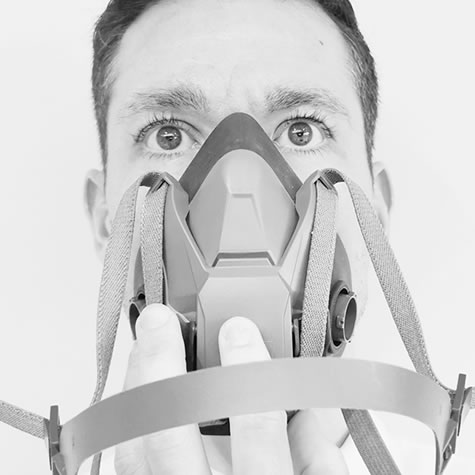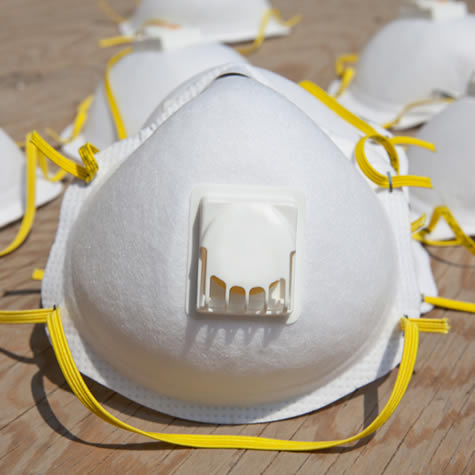Qualitative Face-Fit Testing In Brynmawr
On Site Face Fit Testing In Brynmawr
If your company is based in Brynmawr and you require qualitative face-fit testing for your employees, we at Fire Coral Ltd can provide you with testing by a Fit2Fit accredited provider.
As part of your company health and safety remit, if you provide your staff with respiratory equipment (RPE) you require certification that they fit your staff correctly, are used in the correct manner, and maintained in line with legal requirements. The Health & Safety Executives (HSE) guidance note INDG 479 lays bare the need for face fit testing.
Face-fit testing is required, especially if your employees work in a dusty environment within Brynmawr. The COSHH (Control of Substances Hazardous to Health) Regulations state then when selecting RPE equipment, a face-fit test is a way of ensuring an adequate seal is achieved. Did you know over 50% of masks tested on those with no training failed a face fit test.
By following the guidance laid out in INDG 479 & HSG 53 with regards RPE, you are meeting the regulatory requirements expected of you.
Book Your Face Fit Testing Today
Give us a call to discuss face-fit testing your employees in Brynmawr
Qualitative Face Fit Testing Firm That Covers Brynmawr
All close fitting masks should be face fit tested on the wearer to demonstrate whether they work or not. The types of masks which would need face-fit testing include, disposable face masks (FFP3), half masks & full-face masks. Here at Fire Coral Ltd, we provide qualitative testing for workers in Brynmawr using half-face disposable or reusable masks only.
Brynmawr Face Fit Testing
A face fit test is a set of exercises simulating everyday movement to determine whether an adequate seal is maintained. There are 7 exercises which each staff member should complete, each lasting for 1 minute. If one of the exercises is failed, the whole test needs to be re-taken. We will test your staff in groups of nine in slots 1.5 hours apart to minimise downtime to yourselves.
On Site Face Fit Testing Companies That Cover Brynmawr
Normal working conditions should be simulated during the test, as mentioned in INDG 479. It is recommended that staff should be using dynamic movements such as walking, stepping and cycling on exercise machines.
If your staff in Brynmawr use RPE on a regular basis, and you would like to ensure they are fully trained in the wearing, fitting, and use of their respiratory equipment; Fire Coral Ltd can provide you with a tailored training package at a preferential rate.
About Brynmawr
Brynmawr lies on the northern fringe of the south Wales coalfield in what was formerly Breconshire, and was one of dozens of communities that was irrevocably transformed in the 19th century by the region’s iron and coal industries. Like many industrial communities in south Wales, Brynmawr experienced periods of prosperity and hardship as the region’s fortunes fluctuated with the price of iron and coal. It suffered greatly during the depression years prior to World War II, when massive unemployment threatened the peace and stability of the community. However, Brynmawr has made a remarkable recovery from those difficult times, and today its residents take great pride in the town’s recent accomplishments. These include the recently opened Brynmawr and District Museum on Market Street, a valuable archive that pays tribute to Brynmawr’s past. Falling between the valleys and the open moor land of the Brecon Beacons, Brynmawr has never thought of itself as a valley town, if fact it had a much higher opinion of itself since it was actually in Breconshire and it is after all the highest town in Britain. Breconshire is mainly a farming county; Brynmawr was maybe more of a market town. There were large markets held here, many of the sellers being farmers and local traders and until only a few years ago when the new boundary changes said we were now in Blaenau Gwent, our Saturday Market brought people in from quite a large catchments area. There were fairs held twice a year that brought people from miles around either to buy, just look or hire workers. In Welsh they would be called Ffair Calan. So where exactly does Brynmawr stand? At just over 1000 feet above sea level, Brynmawr is a very young town, planned on a grid system and only about 200 years old. Before 1800 there were only a few scattered farms, Blaen Nant Farm and Bryn Farm for example or shepherds cottages. It came into being by accident. It was and still is a Dormitory town. People live here but need to travel to work. This has not been good for the town in the past. There was no heavy industry as there were in so many of the valley towns. The growth of Brynmawr depended on the work available nearby. In 1794 the Clydach railroad opened, this provided a route to the canal at Gilwern along which coal dug in this area could be transported to the larger towns of Brecon and South towards Newport but it was the iron works at Nant y Glo opening in 1795 that was the catalyst. Originally started by Harford it became a success under the leadership of Joseph and Crawshay Bailey.Both brothers were born in 1789 in Great Wenham, Suffolk, the sons of John Bailey, of Wakefield and his wife Susannah. Their parents had moved from Normanton, near Wakefield in around 1780. Legend has it the brothers walked to find work at their uncles (Richard Crawshay) iron works at Cyfarthfa in Merthyr Tydfil. When their uncle died, he left them both some money which they wisely invested and Nant y Glo became, in its day, the most important iron works in the world. They also provided houses for their workers and a school and yet they used child labour even after it was made illegal by parliament. Both Joseph and Crawshay bailey became M.P.s evenually.At first it was small cottages built alongside the tram roads that criss-crossed the mountain carrying the raw materials to the iron works. Iron, limestone and coal were available nearby and the canal at Gilwern meant the iron, coal and limestone produced could be transported to larger towns such as Brecon or Newport. The area was called Waen Helygen, (Willow Moor), Brynmawr was a name for one of the farms on the moor. It became the towns name originally for the area around Clydach Bridge where you enter the town. There were two blacksmith forges there, needed to shoe the numerous horses that were used to haul the drams. By 1812 a turnpike road connected Merthyr Tydfil and Govilon; (an original idea of Richard Crawshay who saw the benefit of joining the iron works that stood along the heads of the valley), this ran along what is now King Street or The Kings Highway.As demand for workers houses grew, the moor land became the obvious place. To start with there was very little room at Nant y Glo but living on the moor meant you were far from the noise and pollution of the iron works yet still near enough to be able to walk to work. The town began to grow as houses are built alongside King Street and the tram roads that criss crossed the moorland; Well Street, Bailey Street, Intermediate Road and so on; and the planned grid section comprising Hatter Street, Boundary Street, Orchard Street and Chapel Street all crossing Worcester Street at right angles. By 1844 the town had a Market Hall; this though was replaced in 1894. As Brynmawr developed, the earlier streets were named after the Duke of Beauforts family who owned the land. In contrast to other valley towns the town has a number of very fine, very large houses. You only have to walk down Alma Street or King Street to see that; obviously they were not built for the workers at the iron works.The railway arrived in 1862 and the town became a very important rail centre. The MTA, Merthyr, Tredegar and Abergavenny Railway Company whose Chairman was Crawshay Bailey connected along the top of the valleys but no link to Newport. The M.T.A. was eventually taken over by the L.N.W.R. The G.W.R came up to Nant y Glo from Newport but it wasnt until 1905 that the missing link to Brynmawr Railway Station was opened. Finally a link South and Brynmawr had two railway platforms, the L.N.W.R. and the G.W.R. Now the town became the junction of lines from Merthyr, Tredegar and Ebbw Vale; from Abergavenny, from Blaenafon and south from Abertillery and Newport. The town became a very important rail junction and it was this coupled with a very fine hotel that attracted so many pack men and traders to the town to eventually settle.The demise came suddenly. Nant y Glo iron works ceased production along with so many others in the valleys. The Baileys sold the works in 1870 and after that it never came to much. Brynmawr had no heavy industry but there was always a tradition of boot making in the town, essential footwear for the iron works or the mines. One famous boot maker was David Lewis or King Crispin as he was known. He led the Brynmawr Chartist on the march to Newport in 1839 and a boot factory had been established in 1850. The coal mines of the valleys looked after their own, if there were to be any redundancies it was the outsider who was the first to go and Brynmawr suffered because of this By the 1920s the unemployment figures for the town was something like 90% but help was on the way. In 1928, Peter Scott a Quaker along with a number of colleagues made the initial steps to gain the towns people confidence to co-operate in a venture that would help restore hope and self respect to the community. A number of projects were initiated, building a swimming pool and landscaping the surrounding area, furniture making and so on. This was opposed by the local Labour Party and the Communist Party who were very strong in the town. The project was successful and the Brynmawr furniture factory continued until 1940 when it closed due the unavailability of the raw materials needed and the lack of demand for quality furniture during the war years. After the Second World War, again the town suffered with unemployment. The next venture was the Brynmawr Rubber Factory that became Dunlop Semtex. To be pedantic it is not in Brynmawr, its in Nant y Glo, the only part of the unit actually in Brynmawr is the Boiler House and that is the only part still standing. The rest so they say is underneath Asda. The factory closed in 1981 when Dunlop moved their production to South Africa. The Factory was unique in many ways, management and labourers entered via the same door, management and labourers shared the same canteen and wash areas.




